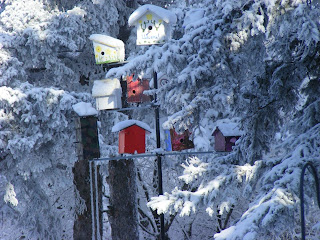- A group of jays is called a; Band / Party / Scold
- The blue Jay is a busy vocal bird. It has been known to mimic other birds and even human speech. They are one of the most colorful and easily identified bird. It eats seeds, nuts and acorns. It is also easy prey for hawks, owls and other birds of prey because of its colorfulness and slow flying speed. Curious and intelegent it adapts to urbanization.

- 15; Downy Woodpecker
- This busy bird feeds mainly on beatle larve and seeds during winter. It is smaller than the Hairy but can be seen with and around them. It loves feeders with tallow or suet base.
- Travis, Logan and Conner saw these and will do the write up. Way to go guys. Mel and Willow saw a seagull and some geese but was not sure what type, later tomorrow.
-




























